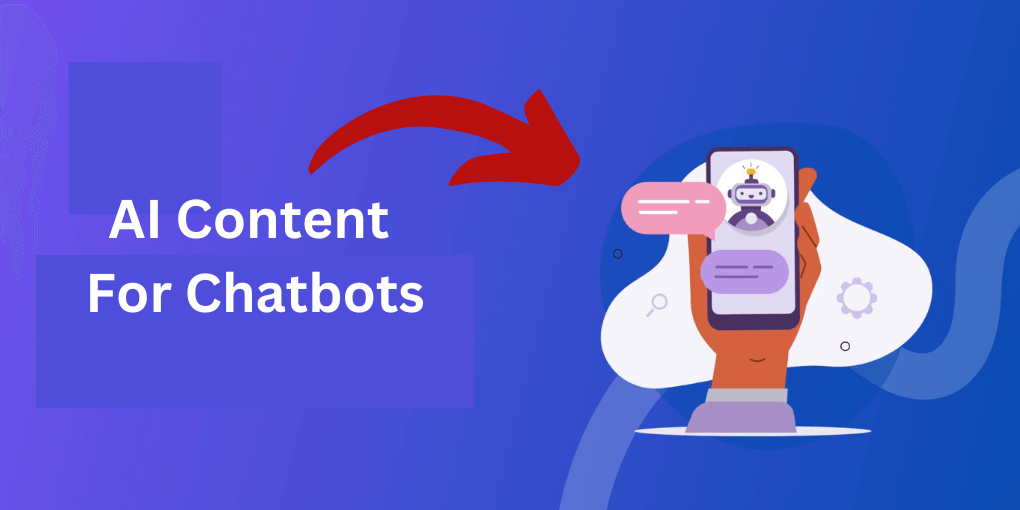Unlock the potential of AI for chatbot strategy by leveraging intelligent and engaging content.
AI (Artificial Intelligence) has revolutionized various industries, including the field of chatbots. Chatbots are computer programs that are programmed to converse with users.

One of the key components of an effective chatbot is the content it generates. In this article, we will explore the benefits and challenges of using AI-generated content for chatbots.
What is AI-generated content?
AI-generated content refers to text or responses that are automatically generated by AI models.
These models are trained on vast amounts of data and can mimic human-like language patterns.
In the context of chatbots, AI-generated content is used to provide responses to user queries or engage in conversations.
Benefits of AI Content for Chatbots
AI-generated content brings numerous benefits to chatbots, enhancing their capabilities and improving the user experience. Here are some key benefits of AI-generated content for chatbots:
Natural Language Processing
AI algorithms enable chatbots to understand and process human language in a more natural and conversational manner.
By analyzing large amounts of text data, AI can generate responses that are contextually relevant, coherent, and tailored to the user’s intent.
This improves overall communication and makes the chatbot more effective in understanding and responding to user queries.
Personalization
AI-generated content allows chatbots to provide personalized responses and recommendations based on user preferences, behavior patterns, and historical interactions.
By leveraging machine learning algorithms, chatbots can analyze user data and deliver tailored content, enhancing the user experience and building stronger engagement.
Efficiency and Scalability
AI-generated content enables chatbots to handle a large volume of inquiries simultaneously, ensuring quick and efficient responses.
Unlike human agents, chatbots powered by AI can handle multiple conversations concurrently, providing instant support and reducing wait times.
This scalability makes chatbots a valuable tool for businesses, especially during peak hours or high-demand periods.
Continuous Learning and Improvement
AI algorithms facilitate continuous learning for chatbots. By analyzing user interactions and feedback, AI-powered chatbots can adapt and improve their responses over time.

Through techniques like reinforcement learning, chatbots can optimize their performance, learn from successful interactions, and identify areas for improvement, leading to better customer service and user satisfaction.
Multilingual Support
AI-generated content enables chatbots to provide multilingual support, breaking down language barriers and catering to a global audience.
With AI algorithms that can process and generate content in multiple languages, chatbots can communicate with users from different regions, cultures, and language backgrounds, expanding their reach and effectiveness.
24/7 Availability
AI-powered chatbots are available round the clock, providing instant assistance and support to users at any time.
Unlike human agents with limited working hours, chatbots can handle inquiries and provide information or solutions outside of regular business hours.
This accessibility improves customer service, enhances user experience, and ensures timely responses to user queries.
Consistency and Accuracy
AI-generated content ensures consistent and accurate responses from chatbots. Chatbots powered by AI algorithms follow predefined rules and guidelines, reducing the risk of human error or inconsistencies in information.
This reliability builds trust and confidence in the chatbot’s capabilities, enhancing its effectiveness as a support tool.
Challenges of AI content for chatbots
While AI-generated content brings numerous benefits to chatbots, there are also several challenges that need to be addressed. Here are some key challenges of AI content for chatbots:
Contextual Understanding
AI algorithms may struggle with accurately understanding the context of user queries.
Chatbots need to interpret and respond to nuanced or ambiguous language, slang, or context-specific references.
Without a comprehensive understanding of the conversation context, chatbots may generate irrelevant or inaccurate responses, leading to a frustrating user experience.
Language Limitations
AI-generated content in chatbots heavily relies on the training data available. If the training data is primarily from a specific language or domain, chatbots may face challenges in understanding or generating content in other languages or specialized fields.
Language and domain limitations can hinder chatbots from effectively communicating with a diverse range of users or addressing complex topics.
Biases and Discrimination
AI algorithms can inadvertently reflect biases present in the training data or the underlying algorithms themselves.
This can lead to biased content generation, perpetuating stereotypes, or discrimination. Care must be taken to ensure ethical and unbiased AI content, by carefully curating training data and implementing fairness measures during the development process.
Lack of Creativity and Emotional Intelligence
While AI algorithms excel at generating responses based on patterns and data, they may struggle with displaying creativity or emotional intelligence.

Chatbots may lack the ability to provide nuanced or empathetic responses in certain situations, which can impact the user’s emotional connection and satisfaction with the chatbot interaction.
Privacy and Data Security
AI-powered chatbots often rely on collecting and analyzing user data to provide personalized experiences.
However, privacy concerns arise when sensitive user information is stored or misused.
It is crucial to implement robust data protection measures, adhere to privacy regulations, and ensure transparent data handling practices to maintain user trust.
Practices for using AI content in chatbots
When using AI-generated content in chatbots, there are several best practices to consider.
These practices can help ensure the effective and responsible use of AI-generated content. Here are some key best practices:
- Training Data Quality: Use high-quality and diverse training data to train AI models. The training data should accurately represent the desired language patterns, user queries, and topics the chatbot is expected to handle. Curate the training data to minimize biases and ensure it covers a wide range of user scenarios and intents.
- Contextual Understanding: Implement techniques that enable chatbots to understand and interpret the context of user queries. This includes considering the conversation history, user preferences, and any available contextual information to generate relevant and accurate responses. Use contextual understanding to improve the flow and coherence of the conversation.
- Regular Monitoring and Testing: Continuously monitor the performance of the chatbot and regularly test its responses. Monitor user feedback and conduct user testing to identify areas for improvement. This allows for ongoing refinement and optimization of the AI models, ensuring that the chatbot provides accurate and satisfactory responses.
- Human Oversight and Intervention: Incorporate human oversight and intervention in the chatbot’s operation. Human reviewers or moderators can help review and validate AI-generated content to ensure its quality, relevance, and adherence to ethical guidelines. Human oversight also allows for the identification and rectification of any biases or inaccuracies in the AI-generated responses.
- User Feedback and Iterative Improvement: Encourage users to provide feedback on their interactions with the chatbot. Use this feedback to identify areas where the chatbot can be improved and to better understand user needs and expectations. Continuously iterate and update the chatbot’s AI models based on user feedback and evolving requirements.
Maintaining a human touch
Maintaining a human touch is a crucial aspect when using AI-generated content in chatbots.
While chatbots offer efficiency and scalability, it is important to create a sense of personal connection and empathy. Here are some strategies to maintain a human touch in chatbot interactions:
Emulate Natural Language
Train the chatbot to generate responses that sound more human-like. This includes using conversational language, appropriate tone, and expressions that resonate with users.
Avoid overly robotic or mechanical responses and strive for a conversational tone that reflects empathy and understanding.
Acknowledge User Emotions
Incorporate the ability to recognize and respond to user emotions. Chatbots can be programmed to detect certain emotional cues or keywords and provide empathetic and supportive responses.
Acknowledging emotions helps create a more human-like interaction and demonstrates care and understanding.
Use Personalization
Leverage user data to personalize the chatbot’s responses. Address users by their name, reference previous interactions, and tailor recommendations or suggestions based on their preferences.
Personalization creates a sense of individualized attention and enhances the user experience.
Provide a Clear Brand Persona
Define a clear brand persona for the chatbot and ensure its responses align with the brand’s values and tone.
This helps establish consistency and familiarity, making users feel more comfortable interacting with the chatbot.
Offer Escalation Paths
Design the chatbot to recognize situations where human intervention may be necessary or preferred.
Provide clear options for users to escalate their queries or concerns to a human agent when needed.
This allows for a seamless transition from the chatbot to a human representative, ensuring a personalized and effective resolution.
Conclusion
In conclusion, the integration of AI-generated content in chatbots offers numerous benefits, including natural language processing, personalization, efficiency, and scalability.
However, it is essential to address the challenges associated with AI-generated content, such as contextual understanding, biases, lack of creativity, privacy concerns, and user trust.
By following best practices, such as maintaining a human touch, organizations can overcome these challenges and create chatbot experiences that are engaging, empathetic, and effective.
Strategies like emulating natural language, acknowledging user emotions, personalizing interactions, providing clear brand personas, offering escalation paths, incorporating humor, and continuously improving the chatbot contribute to a more human-like experience.

This blog post is written by AI Genie, Powered by ContentGeni’s cutting-edge AI technology. It is able to quickly and efficiently produce high-quality written content on a wide range of topics. While AI Genie may not have a physical body, it is constantly learning and evolving to provide the best possible content for its readers.